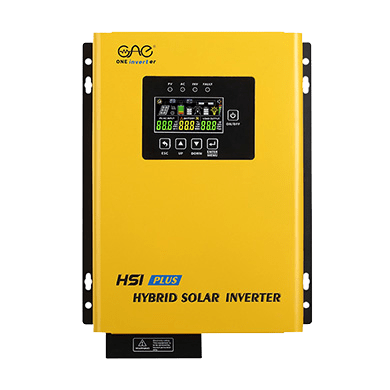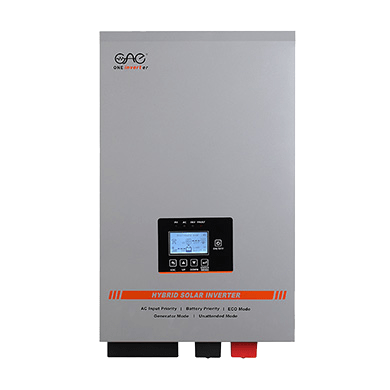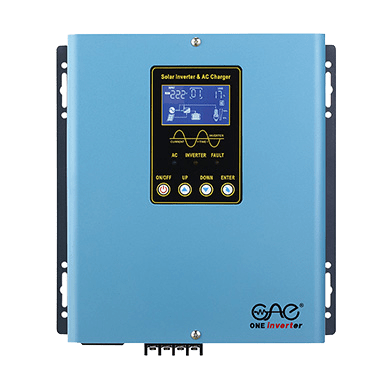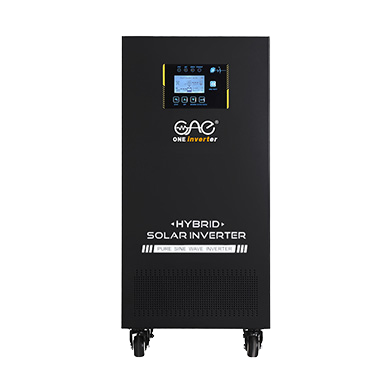In recent years, there has been an increasing global focus on sustainable development. Solar energy has grown in popularity due to its renewability. It will not only reduce greenhouse gas emissions but will also ease the pressure of energy consumption on natural resources. There is a core component in the solar system is the solar inverter, its role is very critical.
The main function of a solar inverter is converting the direct current (DC) generated by the solar panel into alternating current (AC). The most used form of electricity in our homes and on the grid is alternating current, therefore, solar inverters have an important role in this matter. Proper selection of solar inverters can help improve the overall efficiency and system reliability of solar power generation.
Here we will provide you with a comprehensive guide to help you understand the features, advantages, and disadvantages of different types of solar inverters. We will also talk about key factors to consider when choosing the best solar inverter, such as efficiency, reliability, and various other features of the inverter so that you can make the right choice according to your needs.

A solar inverter plays an important role in the solar power generation system. Its purpose is not limited to converting power, but also as the core component for performance improvement and economic benefits of the system.
Solar inverters are power conversion devices that are designed to convert the direct current from solar panels into alternating current for use in the home, commercially, or industrially. Inverters are an essential part of ensuring solar power systems are compatible with existing power systems, as both modern power grids and most electrical equipment require alternating current.
In addition to the above basic power transformation function, solar inverters also have a very important function in monitoring voltage and energy management safety protection.
The inverter can monitor the voltage, power frequency, and other parameters of the grid or load in real-time within the whole solar power generation system and guarantee that all the power generation functions can work with maximum efficiency and automatically disconnect the grid tie in case of a problem at the grid or upon failure of the system to prevent the equipment from being damaged.
Different applications, scenarios, and requirements require different types of solar panel inverters. The four major categories of solar inverters include string inverters, micro inverters, power optimizers, and hybrid inverters.
String inverters are used to connect several solar panels in series and achieve a central conversion of DC into AC. The working principle is the inverter converting DC power, which has been produced by the connected solar panels into AC power suitable for home or commercial use.
This type of string inverter is relatively simple and has a rather small number of components, which means that manufacturing and material costs are relatively low. In comparison with other types of inverters, installation and maintenance costs are also rather low. Therefore, this makes it has a clear advantage in cost and becomes the most economical choice in the market.
String inverters are quite suitable for large-scale solar power generation systems because they can operate several solar panels in a series. In this regard, a string inverter reduces overall system cost and improves the return on investment, whether it is a big commercial project or a home rooftop system.
However, the disadvantage of string inverters is that if the performance of one panel deteriorates, because of shading, dirt building up, or aging, the output efficiency of the whole string will be affected.
Unlike string inverters, micro inverters are small independent inverters installed on each solar panel that directly convert the direct current into alternating current.
With one inverter per panel, the performance of individual panels does not affect the overall system output. This means that even when some panels are partially obscured by shadow, other panels can still function normally. Each panel operates at its maximum power point tracking (MPPT) independently. That is to say, it means the micro inverter system could extract the most power from each solar panel.
However, the upfront cost of micro inverters is significantly higher compared to string inverters. Since each panel must have an independent inverter, more inverters will be consumed in the system. Therefore, the cost is raised tremendously.
Moreover, due to the fact that every panel is equipped with an inverter at the back, the installation of the whole system is also more complicated. Therefore, the labor cost for installation may also be higher.
A power optimizer is installed on each solar panel and is an electronic device that is designed to optimize the power output of each solar panel. Its main role is to maximize DC output efficiency for every PV module using module-level MPPT.
Unlike micro inverters, the conversion of DC directly into AC is not done through a power optimizer, but the consolidated DC of all the panels is pooled into one central inverter, which changes the consolidated DC into AC for the grid or user use.
Like micro inverters, power optimizers ensure that there is the maximum output of each panel by minimizing the effect caused by shades, dirt, and others. Power optimizer centralizes with a string inverter, which retains the advantages of a centralized inverter and solves the problem of inconsistent performance of a single panel.
Despite this higher upfront cost and slightly more complex installation, the power optimizer provides long-term gains in efficiency as well as module-level monitoring. This therefore makes it very relevant in many project applications, mainly residential and small to medium commercial installations.
A hybrid inverter is a multifunctional inverter, and its fundamental function is to convert the DC power produced by solar panels into AC for grid or home use. It also could be combined with a battery energy storage system to store excess solar power.
When the power generation exceeds the demand at the time, the hybrid inverter will store the excess power in the battery for later use. It is for this reason that the design makes hybrid inverters very suitable for home and commercial energy storage solutions.
However, compared to a traditional string or micro inverter system, hybrid inverters have much higher purchasing and installation costs. This is mainly because it integrates a battery management system inside and often requires additional energy storage systems of batteries, which increases the overall cost.
Despite their high cost and complex system installation, hybrid inverters have broad prospects due to their self-sufficiency, off-grid operation, and long-term energy-saving potential.
The core function of solar inverters is to convert the direct current developed by the solar panel into an alternating current. The inverter adjusts the voltage, frequency, and phase to ensure that the output power meets the grid standards, thereby achieving a stable power supply.
It includes several key steps in the workflow of the inverter in particular: first, there is direct current input. The inverter receives direct current generated through photovoltaic power generation by the solar panel. Through a current conversion step, the inverter converts direct current to alternating current.
Then, through waveform modulation, the inverter uses pulse width modulation (PWM) technology to generate sinusoidal waveform so as to guarantee the quality of the output current. Finally, the inverter uses transformers or other electronic devices to regulate the output voltage so that it conforms to the requirements of the grid standard.

The right choice of a solar inverter can not only guarantee efficient operation of the system but also ensure stability, economy, and long-term benefit of the whole system. When choosing the best solar inverter, there are some key factors you have to take into consideration. Below, we detail these to help you make your informed choice.
The efficiency of a solar inverter mainly refers to the capability for direct current to be transformed into alternating current and is usually expressed as a percentage. The higher the efficiency, the more electrical energy can be efficiently converted, which can reduce energy waste.
Inverter efficiency directly affects the power generation capacity and economic benefits of the overall system, therefore, it is one of the most critical factors to be considered when choosing an inverter.
Even with low power generation, such as morning, evening, or on cloudy days, highly efficient solar inverters ensure that the energy is still maximally produced. This can increase the overall power generation of the system.
Inverter efficiency is not only important for energy generation, but it also plays a direct role in economic efficiency. The greater power conversion implies that the user will rely less on the external grid and can reduce electricity bills, especially in areas where the price of electricity could be quite high or tend to rise year after year.
The power rating indicates the maximum power output capability that the inverter can handle. Choosing the right power of the inverter can guarantee that the system will not get damaged because of overload, and can also avoid unnecessary waste caused by more-than-enough inverter capacity.
The proper power rating is to be chosen in correspondence to the total power of the solar panel. A solar inverter with too low power rating cannot handle the output power of the whole system, while one that is too high may lead to increased cost and reduced efficiency.
When deciding the power rating, future growth in demand for electricity and possible expansion should also be taken into consideration. If you are going to add some solar panels or load equipment, you should select an inverter with enough redundancy so that the system can respond flexibly to future changes.
The solar inverter needs to match the voltage and current parameters of the solar panel. This is because mismatched voltage or current can lead to decreased efficiency or potentially, which will cause harm to the panel or inverter. As a result, choosing the right inverter and comprehending the solar panel’s specifications are crucial.
The electrical properties of various solar panel types, such as thin-film, polysilicon, and monocrystalline silicon panels, might vary. For instance, polycrystalline silicon panels are slightly less efficient but more reasonably priced than monocrystalline silicon panels, which typically have more steady voltage and current outputs.
Most solar panel manufacturers guarantee that the system achieves the best conversion efficiency during real operation by providing inverter specifications and models that correspond with their products. By following the manufacturer’s instructions, you can increase the system’s total energy production efficiency as well as the equipment’s lifespan.
The inverter selected should be suitable for the size of the entire solar system. The power demand gap between small and large solar systems is huge, so the choice of suitable inverters according to the size of the system is the basis for ensuring power generation efficiency and equipment reliability.
For small home solar systems, single-phase inverters are usually the best choice. Home systems are usually installed with a low capacity, which is suitable for the basic power needs of daily household appliances, and single-phase inverters can efficiently convert direct current to meet the electricity needs of ordinary families.
In contrast, large commercial solar systems typically require multiple three-phase inverters to support their high power generation and complex load requirements. Commercial systems’ power output is usually much higher than that of home systems, and the load types are more complex. Three-phase inverters have higher power processing capacity.
Solar inverters with real-time monitoring functions will show the generation situation of the system, detect the coming problems in time, and analyze the data in order to optimize performance. This will be quite vital in having long-term efficiency in energy production.
Web and mobile applications are now available for many modern solar inverters, and real-time operating status of the system can be viewed on these interfaces. Some advanced options can even be integrated into smart home systems to provide a more comprehensive energy management solution.
The biggest advantage of real-time tracking system performance is the ability to detect and resolve problems (such as solar panel occlusion or inverter failure) promptly, minimizing system downtime and increasing long-term power generation benefits. Therefore, it is better to choose a solar inverter with monitoring functions.
The average life span of a solar inverter normally ranges between 10 to 15 years. Choosing a durable inverter can effectively cut down maintenance costs and prolong the life of the whole system.
Warranty periods and conditions differ from one manufacturer to the other. The length of the warranty period generally reflects the confidence of the manufacturer in the quality of the product. When choosing, you need to understand the specific content and limitations that are included in the warranty.
Regular inspection and maintenance of solar inverters can help extend their life. You need to clean the inverter on a regular basis, and good ventilation around it is necessary to avoid overheating. In addition, if the inverter is almost at the end of its service life, updating it in time can also avoid degradation of the performance of the system.
The cost of solar inverters is also a very important aspect. In general, high-efficiency, high-quality inverters are usually priced higher, but with more power generation and less maintenance in the long run, they return more savings on energy costs.
Besides the cost of the inverter itself, you also need to consider installation and maintenance costs. An installation with a complex setup requires more technical support, and the cost may be higher. Regular checkups and maintenance are also an added expense to keeping the system running with stability.
Efficiency, reliability, maintenance and servicing costs of inverter, and energy savings are all vital to determine the overall return on investment (ROI) of the solar system. Choosing an efficient and long-term reliable inverter can not only improve the power generation efficiency of the solar power system, but also improve the ROI of the system, bringing you more lasting economic benefits.

With the continuous advancement of technology and the growing demand for renewable energy, solar power generation systems are becoming more and more popular and efficient. The technology of solar inverters is also constantly innovating. Below we will introduce the emerging technologies and trends of solar inverters in detail.
In recent years, technological developments related to solar inverters have raised the performance standard concerning solar power generation, specifically, higher conversion efficiency.
Traditional inverters’ efficiency is between 95% and 98%, which means the energy converted from DC to AC will lose 2% to 5%. It may not seem like that much, but for large systems, the losses can add up over time. Therefore, improving inverter efficiency has always been one of the main goals of technology research and development.
Recent technological developments have led to increased development of newer, more efficient inverters with efficiencies up to 99%. This has largely been enabled by better semiconductor technology, allowing for better heat management and faster switching speeds. This will minimize the energy loss and maximize the energy output of the solar system.
Most importantly, reducing energy loss in the process of conversion raises the overall efficiency of power generation by the solar system and thus directly increases energy output and economic return.
Smart inverters are changing the solar industry by offering more functions than conventional inverters. Conventional inverters are only used to convert DC into AC, smart inverters can also establish two-way communication between the power grid and other devices, enabling the device to monitor real-time system performance and automatically optimize energy output.
The other key role played by smart inverters is that of support for demand response planning. Demand response is a strategy utilized through which power grids manage energy loads at peak use time. Smart inverters would automatically adjust to the real-time grid conditions and would cut the amount of electricity that feeds into a home or business during peak times.
When the grid is being put under too much pressure, smart inverters can reduce output from the solar system or store excess power rather than send it to the grid, hence relieving demand pressure.
In addition, smart solar inverters are enabled with voltage regulation and frequency response features that can maintain power quality and stability. When the grid has voltage or frequency problems, they can quickly adjust the output in response.
As battery storage technology becomes more and more widely used in the home and commercial sectors, the close synergy between solar inverters and batteries becomes critical. Hybrid inverter technology integrates solar power generation with battery storage and is now fast emerging as a mainstream solution.
Hybrid inverters enable users to store excess power generated from the solar panels during the day for use at night or during peak periods of electricity demand.
Besides, hybrid inverters can significantly improve the overall efficiency of the solar system by maximizing the utilization of solar power, helping to build a more sustainable energy system. By storing excess solar power, users can reduce their reliance on traditional power sources, thereby reducing greenhouse gas emissions and energy waste.

In short, choosing the right solar inverter is critical to maximizing the efficiency and performance of your solar system. The inverter, which is the central component of the system, transforms the direct current (DC) produced by the solar panels into alternating current (AC), which is then suitable for use in domestic appliances and for returning excess energy to the grid.
Understanding the differences between string inverters, micro inverters, power optimizers, and hybrid inverters is the first step to selecting the best solar inverter. Each has benefits and drawbacks, so which one you select will rely on your requirements. Think about important aspects like cost, durability, compatibility with system size, efficiency, power rating, and so on before making your decision.
Future solar inverters will be more efficient due to advancements in technology. Investing in the best solar inverter is definitely worth it! Not only will it help you increase your energy output, it will also extend the life of your solar system while contributing to a sustainable energy future. If you want stable performance and high reliability, One Inverter’s solar inverter is a good choice to provide you with outstanding performance and long-term protection.